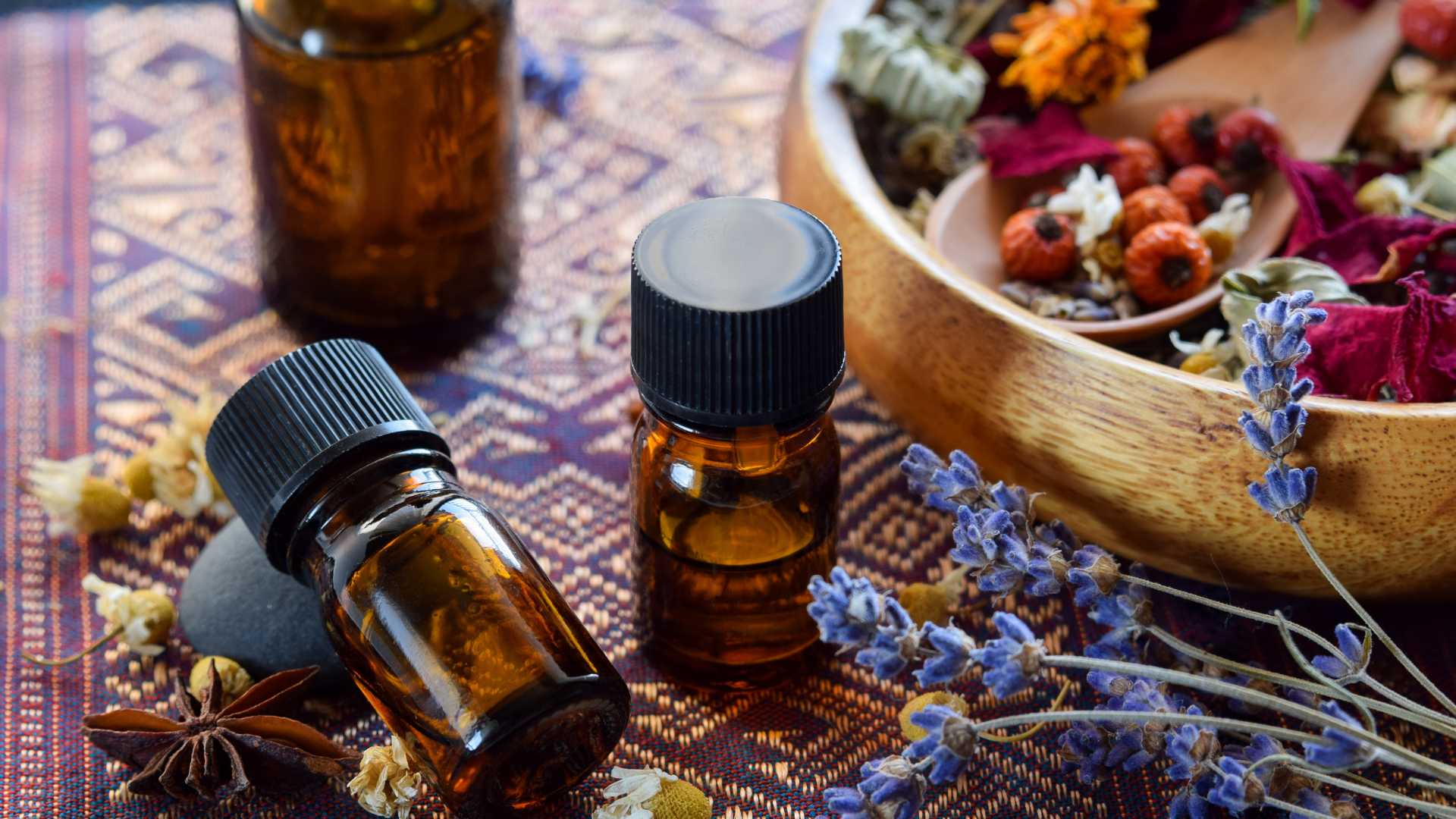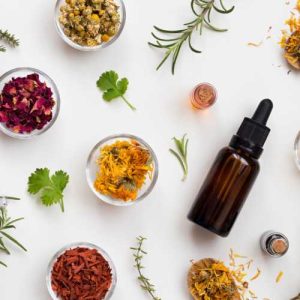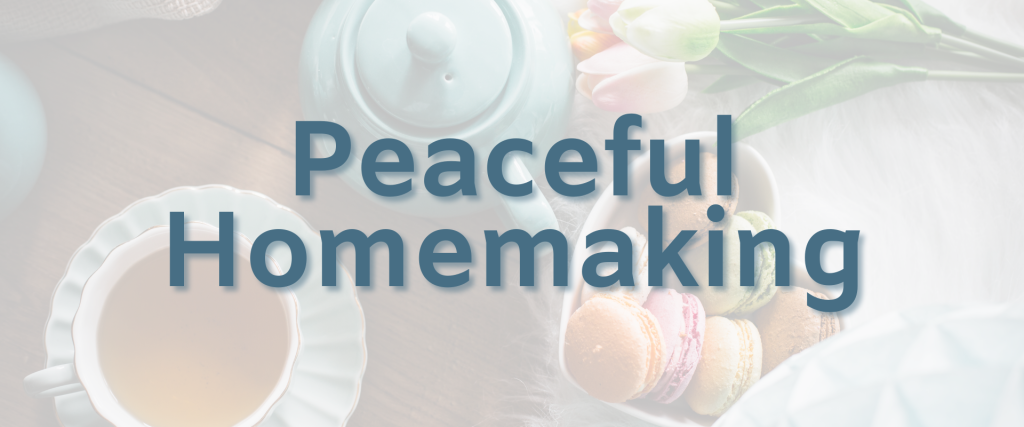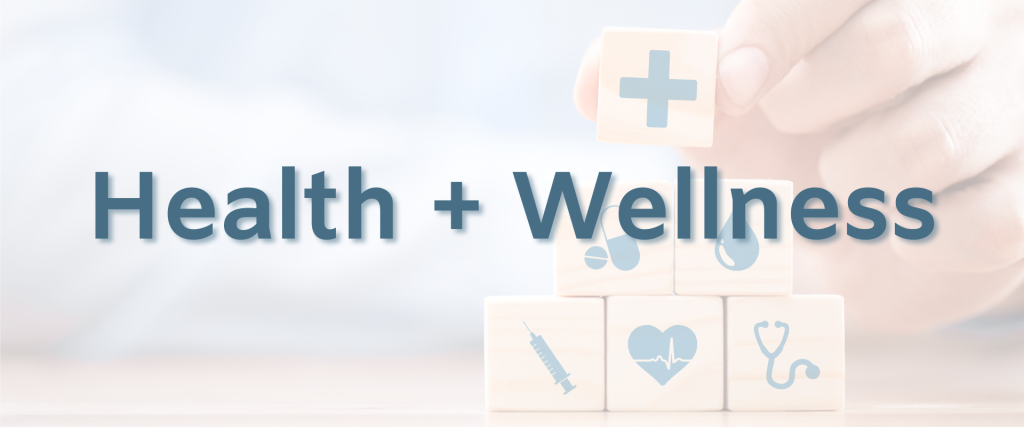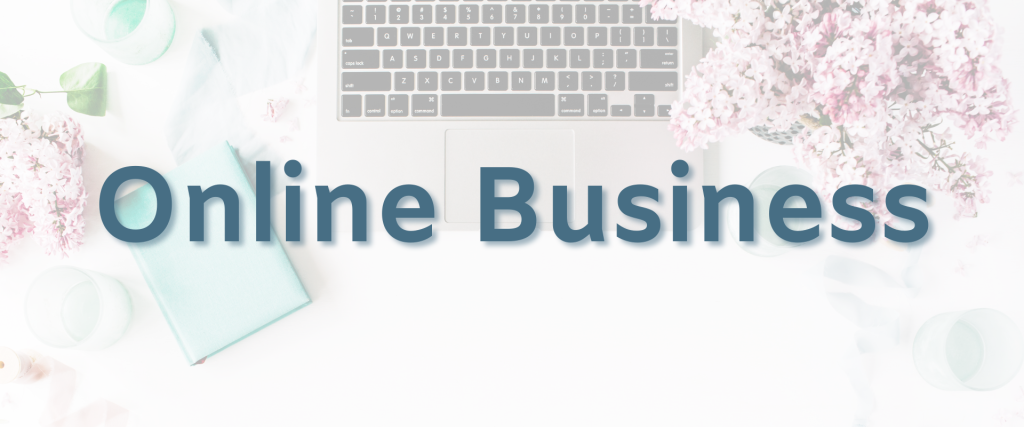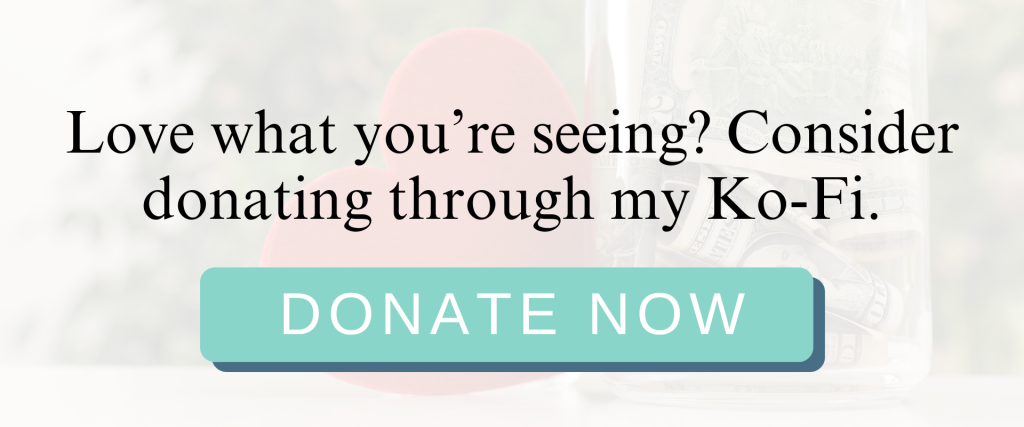Welcome to your crash course on essential oils! In this article, you’ll learn the basics to get started with essential oils confidently and safely.
This article is going to outline a lot of information that is designed to lay a firm, albeit basic, foundation for using essential oils in your daily life.
As you read this article, the goal is for you to learn the very basics of essential oils. This is not a complete, exhaustive guide. This article is written with the absolute beginner in mind.
You don’t have to have any prior knowledge or experience with any kind of natural or homeopathic medicine, nor do you need to know anything about herbs and plants. You simply need a desire to learn and a willingness to acquire new skills and be better informed on how to care for yourself holistically.
A quick disclaimer:
This and any other similarly fashioned article are for educational and informational purposes only.
I am not a doctor, medical professional, or eastern medicine practitioner. The information provided to you in this and other related articles is shared with the sole purpose to educate, encourage, and inspire you to take ownership of your whole well-being and to not just take what other medical professionals, etc, say as fact.
Please take responsibility for your health and life, as well as that of your family and don’t simply take other people’s words for it. Do your research and don’t be afraid to seek answers from a naturopathic doctor or other herbal medicine trained/licensed practitioner.
Additionally, while I am a Young Living Brand Partner, I will never, in anyway attempt to persuade anyone into buying from a specific company. I followed the same procedure that is listed in this article. In doing my due diligence, I chose to purchase essential oils and other products from Young Living. I also choose to share their products based off of my personal experience with them.
All that being said, I also wanted to note that I know it may be annoying to open an article with a certain title and then have it open with a bunch of info you weren’t looking for. There’s a few reasons for that. I won’t get into them here, but I can share about why I format my articles the way I do in a future post.
What are essential oils?
Essential oils are a natural oil that is highly concentrated and is made from plant material using methods such as steam distillation, extraction, cold pressing, or resin distillation.
These oils contain many constituent compounds. Constituents are “a volatile substance—meaning it evaporates rapidly—that contains the natural smell and characteristic of the plant” (The Lavender Life, 2019).
History of Essential Oils
You can see from this timeline (courtesy of The Lavender Life blog) that essential oils have been around and used in various ways for millenia.
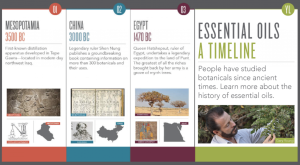
Whether for healing and wellness, ceremonial, or even cosmetic and dietary purposes, essential oils have been used by people for a long time. They aren’t a new phenomenon.
They just seem new and trendy because for the last century or so society’s excitement over the revolutionary advances in technology and medicine lost sight of nature’s bounty that is essential oils and herbal medicine.
All over the world, however, we can see how different cultures still use essential oils for the same previously mentioned purposes today.
Essential Oils in the Modern World
Ayurveda
A helpful article from Cosmetics and Toiletries (2019) says, “Traditional Indian medicine, or Ayurveda, has a 3,000-year history of incorporating essential oils into healing elixirs. Vedic literature lists more than 700 substances including cinnamon, ginger, myrrh and sandalwood as effective for healing.
In fact, much later, during the outbreak of the Bubonic plague, Ayurveda practices and treatments were used successfully to replace ineffective antibiotics” (Cosmetics and Toiletries).
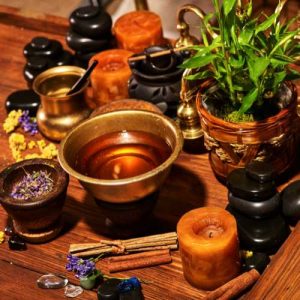 The thing I find so fascinating about Ayurveda is how long it’s been practiced. With its rich history in Indian culture, Ayurveda as a natural medicinal practice is one that has been passed down for generations.
The thing I find so fascinating about Ayurveda is how long it’s been practiced. With its rich history in Indian culture, Ayurveda as a natural medicinal practice is one that has been passed down for generations.
Like its Chinese counterpart, these medicinal practices pioneered what we now know as modern medicine.
However, the modern medicine we experience, especially in the western world, isn’t always sufficient. While it has changed the world for the better with revolutionary advances from ibuprofen to life saving surgeries, for example, we can definitely glean much wisdom and insight from the medicinal ways that came long before.
Acupuncture and Chinese Medicine
In an article from Acupuncture Today (2009), Peter Holmes, LAc, MH, shares a few of the ways he uses essential oils in his acupuncture practice. He begins by emphasizing that there is a difference between perfumed oils and essential oils.
He poses several questions that a practitioner should ask the patient:
- …[A]re [they] using partly synthetic oils that would add to their burden of toxicity from the environment?
- Are the oils affecting their pulses, their tongue or masking their symptoms the way that medications do?
- Is the patient using the oils in a way that balances their condition or in a way that supports their inherent imbalances?
If you’re at all familiar with acupuncture and Chinese medicine, you will be aware of the similarities it has to Ayurveda in that both focus on the whole person—mind, body, and soul/spirit.
Basically, the questions above are asked to get to know the patient better and to see in what way they are using oils, if at all.
I’ll dive deeper into eastern medicine and how we can incorporate it into our western lives effectively in another article. For now, I just wanted to share a few examples of other medicinal practices in which essential oils are used.
Essential Oils 101
Ok, now that the more academic part of this article has been covered (super important stuff, even if it seems a little boring). Let’s now dive into the meat and potatoes, so to speak, of this article.
Where to buy safe, high quality essential oils.
Did you know that there is a right and wrong way to use essential oils? Yes, you read that correctly. Since not all essential oils are created equally, this means that not all essential oils can be safely used in the same ways.
Basically, depending on the company you’re purchasing your oils from, you may be wildly surprised to learn that a lot of lower priced oils on the market don’t actually contain pure essential oil.
 Essential Oil Efficacy
Essential Oil Efficacy
Most lower priced essential oil manufacturers are selling what are known as adulterated oils. This simply means that the bottle of essential oil contains fillers and even possibly synthetic fragrances and chemicals.
For example, some lower priced essential oil manufacturers add in carrier oils like fractionated coconut oil and almond oil into their essential oils.
These carrier oils aren’t a problem, but if a manufacturer is claiming that their essentials oils are 100% pure essential oil, then you shouldn’t be able to find any ingredient except that oil in the bottle.
Knowing where your essential oils come from is critical to safely using them and to their actual potency. You see, those adulterated oils, even if the bottle says they are pure, are not going to have the same health benefits and safe usage as higher quality essential oils.
Since the essential oil industry, like most of the natural wellness industry, is not regulated by any particular regulatory body it is vital that you educate yourself on the company from whom you’re buying your essential oils.
Because of the lack of regulation, companies can say an essential oil is 100% pure even if it has no more than 5% purity. Kind of crazy, I know!
Finding a trust-worthy essential oil company
There are several key components and questions you can ask the company in order to determine whether or not their essential oils are truly high quality and if they are the right fit for you and your family.
- Does your company own the farms from which the plants used in your essential oils are grown? If so, are those farms open to the public to visit for themselves?
- What sorts of quality assurance processes does your company have in place to ensure that your essential oils are safe to use and are of the highest quality and purity?
- Does your company work with doctors and scientists to test and check for deficiencies in your essential oil production process and the final efficacy of the product itself?
If the company you’re asking has nothing to hide, they will be happy to answer your questions and even provide you with more information and resources about their company’s policies and procedures for producing high quality essential oils and essential oil infused products.
How to use essential oils safely.
Now that you know where to get your oils, let’s talk about how to use them safely.
First off, please be sure to follow the instructions found on the label of your essential oil’s bottle. These instructions are there 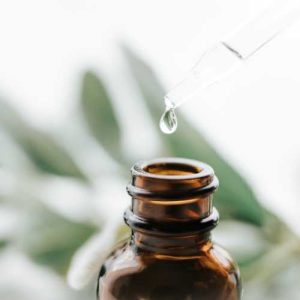 for a reason.
for a reason.
Secondly, it’s important to be clear on what you want to gain from using any particular essential oil or oil blend. Different essential oils and oil blends have different purposes.
Even though many do have overlapping purposes and benefits, it’s still best to understand the basic purposes a certain essential oil or oil blend offers prior to using it.
Aromatherapy
Aromatherapy is probably the number one way you will see people using essential oils. This is also the primary way many essential oil companies label their oils for use.
Aromatherapy has a lot of benefits which we will discuss in the next section Benefits of Essential Oils. For now, all you need to know is that aromatherapy is fabulous and if you haven’t experienced it from essential oils specifically, then you’re in for a real treat.
Basically, aromatherapy can be done in 3 ways.
- Open the bottle of essential oil and lift it towards your nose. Gently inhale and enjoy.
- *Open the bottle of essential oil, place a drop on your forearms and hands, gently rub it in, then cup your hands over your nose and inhale. For added benefits, use 2 drops of essential oil. *See the section on Tips For Using Essential Oils Safely for more information.
- Open the bottle of essential oil and add 1-10 drops to an essential oil diffuser to spread the aroma throughout a space and enjoy the benefits of essential oils for many hours, as they fill the air with their pleasant smells.
Topically
So, I touched (lol) on this in the previous point. As is stated in the essential oils safety section, not all oils are created equally, so take great care when choosing which brand of essential oils you decide to use on your body.
With that being said, using essential oils topically is a wonderful way to experience both the aromatherapy benefits and the skin absorption benefits of essential oils.
The skin is the body’s largest organ. Its purpose is to protect the body from external threats and to act as a filter, protecting the body from many environmental hazards.
The feet and hands have the thickest skin or rather the most layers of skin, while the rest of the body, such as areas that grow hair, have thinner, more absorbent skin.
When applying essential oils to your skin, it’s important to note the instructions for use found on your essential oil bottle’s label, as I’ve
mentioned before.
I want to just emphasize the importance of reading the bottle’s instructions because they are put there to protect you from unnecessarily harming your body.
Essential Oils and Skin
Because essential oils can be absorbed through the skin—some areas of the body, like the feet will take longer to absorb than others—using them topically is a great way to enjoy their myriad of benefits without necessarily ingesting them.
For example, you can rub in 1-2 drops of lavender, lemon, and peppermint essential oils on the bottoms of your feet to help soothe your sinuses and support immunity during pollen season.
Internally
Some essential oil brands have whole lines of essential oils dedicated to internal consumption. These edible essential oils are excellent for anyone looking to experience the benefits of essential oils more quickly.
 For example, when you have nausea from being on a bumpy car ride or stomach gurgles from eating something that didn’t land well, consuming a single drop of an edible peppermint essential oil will give the equivalent of 26 cups of peppermint tea, but with highly concentrated healing.
For example, when you have nausea from being on a bumpy car ride or stomach gurgles from eating something that didn’t land well, consuming a single drop of an edible peppermint essential oil will give the equivalent of 26 cups of peppermint tea, but with highly concentrated healing.
It’s important to, once again, note that the instructions on the label are there to protect you, so please keep them in mind when ingesting edible essential oils. For the most part, most essential oil companies will have clearly labeled their essential oils as for external use only.
However, there are some companies whose essential oils are of a pure, high quality, that have been rigorously tested. These are the essential oil companies who offer edible essential oils that you can trust.
Always Do Your Due Dilligence
No matter what, do your research, ask the questions I shared in the essential oils safety section of this article, and use caution when adding essential oils into your wellness routine.
While they are highly potent and effective little helpers, they can be dangerous if used inappropriately, such as with causing skin irritation as I mentioned previously.
Tips For Using Essential Oils Safely
- Before using essential oils on your skin, follow the instructions found on the label of the bottle. If the bottle suggests diluting the essential oil, only use carrier oils that are fatty oils—such as fractionated coconut oil, almond oil, or olive oil.
- Next, you’ll want to do a spot test on an area of skin that is easy to monitor—the forearms are typically the best place for this.
- Monitor the spot-treated area for 24 hours. Look for signs of irritation like redness, itching, and burning. If any of these signs occur, dilute the area with more carrier oil to help reduce its effects.
- Do not continue using that oil if you experience moderate to extreme sensitivity. Do not rinse with water, this will exacerbate the irritation. Simply continue diluting with carrier oil until symptoms cease. If they don’t, contact your healthcare provider.
Helping Your Body Adapt To Essential Oils
The best way to know if you should persist in helping your body adapt to using oils on your skin (topically) is to determine the severity of sensitivity.
If you don’t feel sensitive or the sensitivity is mild, you can help your body adapt to using essential oils in this way by diluting them more and using them a little bit here and there over time.
**Please consult your healthcare provider or seek the advice of a naturopathic doctor for further information on adapting your body to essential oils.**
Benefits of Essential Oils
When looking to add essential oils into your wellness routine, you might wonder how they can actually help you. Essential oils have a myriad of benefits, from helping reduce pain and inflammation from a bee sting or speeding along the healing of a cut to supporting healthy digestion and sleep.
You can use different types of essential oils to support the body’s vast array of systems and functions.
For example, you can add a drop of an immune supporting essential oil blend like Young Living’s Thieves Vitality to a mild flavored tea bag and enjoy both the Christmas-y aroma and its potent healing benefits.
I like to put a drop of it onto a decaf PG Tips tea bag and make my tea latte as usual with some sugar and lactose free milk.
You can also diffuse oil blends like Thieves or Purification essential oil to cleanse and purify the air in your home. Those blends
are excellent for sniffle season, especially when kids are exposed to sniffle-causing issues.
Another great use for both of these oil blends is for supporting healing from bug bites and even cleaning your home naturally.
10 Everyday Uses For Essential Oils
For the purposes of helping the complete beginner get started using essential oils on a daily basis, here’s 10 everyday uses for essential oils.
- Use essential oils as perfume by filling a roller bottle with several drops of your favorite oil mixed with your choice of carrier oil. Rub some onto your forearms, neck, and bottoms of your feet.
- Add essential oils like lavender and eucalyptus radiata to your bath for added relaxation, de-stressing, and supporting healthy skin.
- Add 1-2 drops of an edible essential oil like lemon or grapefruit to a tea bag or to a glass cup of lemonade, juice, or iced tea for additional digestive and energy support.
- Make natural dishwasher powder with citric acid, washing soda, borax, and your favorite citrus essential oils to clean your dishes and dishwasher naturally. Be mindful that this powder only works well in dry climates.
- Add essential oils like frankincense to your favorite moisturizer to enhance its nourishing properties and improve the overall look and feel of skin.
- Diffuse blends like Thieves and Purification when you’re having a house full of people to help ward off sniffles and other unwell feelings.
- Give your snickerdoodle cookies some added spice with an edible cinnamon essential oil.
- Improve scalp health and stimulate blood circulation for healthier looking hair by adding a few drops of rosemary and peppermint essential oils to your shampoo.
- Give your pasta sauce a flavor boost by adding a drop of an edible oregano and basil essential oil.
- Make a clean room refreshing spray by filling a spray bottle with water and adding in 10-20 drops of your favorite essential oil.
Closing Thoughts
Getting started with essential oils doesn’t have to be scary or difficult. Anyone can start using essentials with care. So long as you educate yourself, read label instructions, research essential oil companies, and learn the basic purposes of the oils you’re using.
Now that you have this basic info, you can confidently begin your journey toward transforming your home and life with clean, natural, plant-based products.
You also don’t have to make the shift alone. You join the free mentorship community and see how others are also learning to incorporate essential oils into their lives, one oily product at a time.

